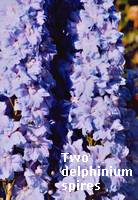How to Grow Delphiniums
Delphiniums are tall, enchanting blooms with a unique form that come in many vibrant colours. They have become a permanent cottage fixture in England, and it is no wonder since they have been hand-pollinated and carefully selected for quality and flare in England since the early 20th Century. Another name for Delphinium is "Larkspur". These beautiful blooms add a touch of grace to any garden and make a wonderful bouquet of cut flowers that will last about seven days in a vase.Delphiniums are often six to eight feet tall, but also come in dwarf varieties of about two feet tall. Dark green foliage is topped with upright, showy flowers. They have bold blooms of the three primary colours-red, blue, and yellow, as well as many blends and combinations. The flower itself has five sepals with three or four petals in the middle (commonly called "a bee"). Biennial and annual delphiniums are available, although perennials are the most common. Delphiniums prefer moist, cool places and blooming occurs in late spring.

Planting Delphiniums
Delphiniums grow best in full sun (six hours a day) away from wind, a like a lot of water in the summer. Be sure to plant in the spring. They can be grown in most soils with good drainage as long as it is fertile and nutrient rich.
Be careful when choosing a spot for delphiniums, as they are not easily moved.
Start with a good, fertile flowerbed and dig a hole twice the size of the plant pot and work in some bonemeal. Place the plant in the hole so the foliage is at ground level and recover with dirt, making sure the plant is positioned firmly. Water immediately and then daily until the plant has settled in.
Delphiniums should never be dry. Mulching may help retain water. Place delphiniums one to three feet apart.
Staking Delphiniums
You will need four bamboo cranes about four feet high for each plant, and some twine. You will find that many bamboo cranes will blend in with the colour of the stems. Make sure your delphiniums are thinned at least two feet high. Insert four bamboo cranes around the plant to form a square. Make the first tie about a foot off the ground to the stem of the plant. It is crucial to tie the stems, and not the tower of flowers. Make the second tie just below the flower spike, about two feet from the ground. If done properly, staking should not be obvious.
Delphinium Cultivation Tips
- Pitfalls of germinating seeds include soaking the soil too much, attempting to grow old seeds, and planting the seed too deeply.
- Thinning delphiniums annually is a must or the plant will exhaust itself blooming.
- Cut all foliage and stems to ground level in the fall.
- Slugs, snails and caterpillars love to feast on delphiniums. Try a bait, pick them off, or try sprinkling with cayenne pepper or cayenne pepper tea after every rainfall to deter them.
- Remove hollow staking canes over winter so that pests can't live in them until spring.
- Make sure your soil has good drainage because waterlogged soils will cause the crowns to rot away.
- In the spring, apply some well-rotted compost around the plant followed by a layer of mulch. Alternatively, simply apply a well-balanced fertilizer.
- After the first frost you may want to cut the stems back about two inches above ground level.
- Divide mature and established plants every three years in the springtime.
- Planting delphiniums in groups of three will be eye pleasing. Keep the groups two feet apart.




Hiç yorum yok:
Yorum Gönder